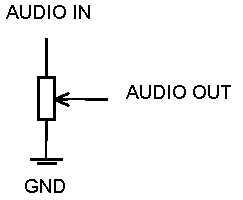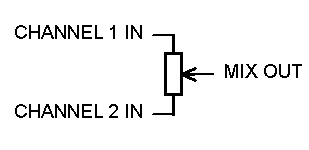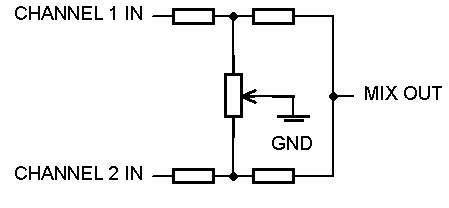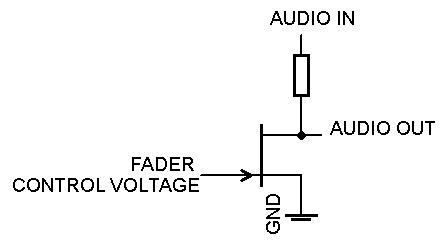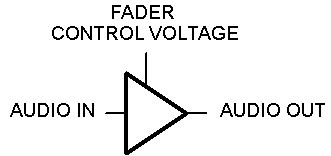Crossfader circuit
Contents
Introduction
Requirements
Turntablists have the following requirements in a crossfader control circuit:
Sharp Curve
The appropriate channel should be fully muted when the fader is in the zero position, and bring the channel to full volume within the first few millimetres of wiper travel. As the curve is so sharp, the exact taper of it is unimportant.
Some fader circuits permit an essentially infinitely sharp curve, where the fader action effectively becomes digital rather than analog. This usually requires some degree of hysteresis (i.e. Schmitt triggering) as the circuit is extremely susceptible to tiny amounts of noise.
Decay time
Full Article with awesome waveforms and harmonic analysis : Decay
Muting an audio signal is not as simple as immediately returning the channel to zero, as this would result in clicks and pops. The signal should instead decay over a few tens of milliseconds. However, if this decay is too large, the signal will take too long to mute and make rhythmic cutting impossible. An ideal decay time would be in the region of 10 to 20 ms.
Some mixers aimed at turntablists have been afflicted with overlong decay times, presumably as a result of turntablists not having been fully consulted in the design process. These include :
- American Audio QD5 MK2
- Stanton SA Series
- Vestax PMC05ProD Samurai
Design Approaches
Early simple circuits
Initial mixer circuits used the crossfader as a component in the audio signal path. This kept the number of components to a minimum, but were very susceptible to wiper noise, and could not support features such as curve control or decay time.
One resistive element per channel
The first crossfader circuits were very simple :
These circuits ran the audio signal through the carbon track, with ground at the other end, and operated like a voltage divider. The wiper pin served as the audio out, and would produce a signal proportional to the distance from the audio source.
This approach required a separate carbon track for each channel, so for two stereo channels four tracks were required. Faders with this configuration were expensive and generated a lot of friction due to the large contact area required.
Tapped circuit
Alternatively, both channels can be connected to the same resistive element, using the wiper as a tap :
This has the benefit of only requiring one resistive element per output channel, but has issues with impedance and crosstalk, and usually requires buffering on the inputs and outputs. Also, it requires a potentiometer with a Sigmoid or "W" taper, which are fairly nonstandard, and many faders with this approach use faders with a less-than-ideal linear taper instead.
Ground pulldown
Another topology to consider effectively uses the wiper as a pulldown resistor that can be moved to either channel freely :
This has much reduced crosstalk and again requires only one resistive element per output channel, but also significantly attenuates the signal, so will adversely affect the signal-to-noise ratio of the circuit. It also requires a sigmoid-taper fader as before.
Mixers that use this topology include :
- Technics SH-DJ1200
- Essentially everything before the Vestax PMC Pro series
Voltage controlled amplifiers
In the mid-90s, performance mixers based on Voltage Controlled, or Variable-gain, amplifiers started to appear. In these designs, no audio signal passes through the fader - instead, a variable voltage is used to control an active electronic circuit, which in turn changes the volume of the signal. This has many advantages
- Filtering - The control voltage can be low-pass filtered to remove wiper noise from the signal. This greatly increases the lifespan of carbon-track faders, as minor wear on the resistive element has less of an effect on the output.
- Reduced Interference - Faders have the disadvantage that they are susceptible to electrical interference. By keeping the audio signal path and control circuit separate, this source of noise is reduced.
- Cheaper Faders - VCA circuits can be made using cheaper logarithmic or linear taper faders, and with appropriate circuitry a single resistive element can control two entire stereo channels (although most VCA mixers use faders with two elements to simplify processing).
- Signal processing - The fader control voltage can be processed to allow for advanced features such as curve control.
Generating the control voltage
This control voltage can come from a number of different places -
- It can be generated directly by the fader itself. This requires no additional components, and can still be filtered using a capacitor, but does not allow for
it can be generated by some analogue circuitry based on a number of factors including fader position, or for even more flexibility it can be generated by a digital microprocessor such as in the Rane TTM56.
There are a number of different approaches to VCA circuit design :
Optocoupler-based VCAs
The optocoupler design uses the control voltage from the fader to drive an LED, which in turn affects the resistance of a photoresistor. This gives a output volume proportional to the voltage input :
Disadvantages to this method include high levels of crosstalk, as it is difficult to completely mute the signal. In addition, optocouplers generally have quite loose tolerances and can easily drift out of specification with age, requiring the circuit to include the ability to manually tune the gain for each channel.
Mixers to use this approach include :
- Early Vestax PMC Pro series (not the ProA or ProVCA series) manufactured in the mid 90s
- Some of the Stanton Mixers perhaps?
Discrete JFET-based VCAs
Another type of VCA circuit can be made using a JFET :
This has the advantage of much more effective muting, and will not drift out of tolerance like an optocoupler, but requires signal biasing and has very poor linearity - i.e, the output volume will not be directly proportional to the control voltage. These factors can be compensated for with external circuitry, but this obviously increases the complexity of the circuit, and requires a lot of complex maths to get right.
Mixers using JFET-based circuitry include :
- Vestax PMC ProA series, manufactured around the turn of the century
Monolithic VCA ICs
Most modern VCA mixers use specialized Voltage Controlled Amplifier ICs :
These are usually FET-based, but include biasing and linear compensation components on-die so can essentially just be dropped into a circuit with very little supporting circuitry.
Many VCAs are/were available, the canonical example being the now-discontinued Analog Devices (formerly Solid State Micro) SSM2164. THAT Corporation still make high quality VCAs such as the 2180LC and the 2162, and some low-end performance mixers (such as the American Audio QD5 MK2) use cheaper hifi-oriented volume control chips.
Mixers using this approach include :
- Vestax PMC ProVCA series
- Technics Technics SH-EX1200
- Rane TTM Series (except the TTM57)
- Essentially all modern analog performance mixers
